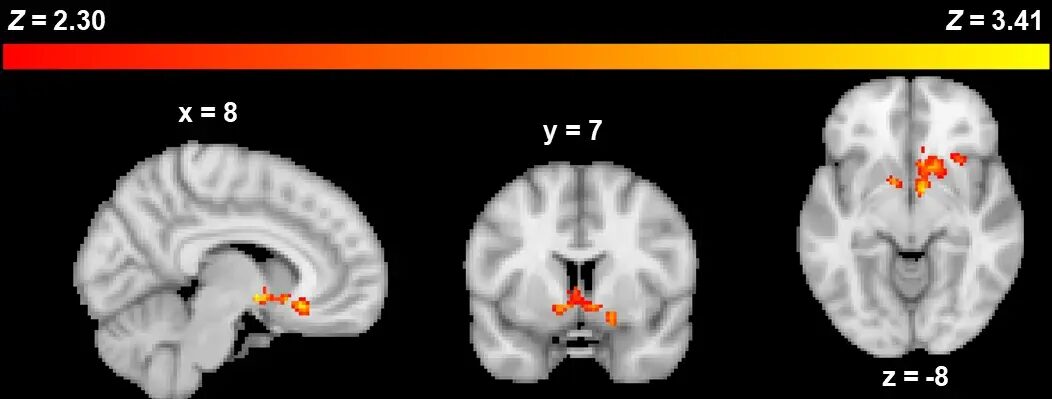
A new study led by researchers at Virginia Commonwealth University used functional brain imaging technology to reveal a potential answer: It increases activity in the brain's reward network.
"At a time of deepening political divisions and global conflict, it is crucial for us to understand why people divide each other up into 'us' and 'them' and then show a profound willingness to harm 'them,'" said corresponding author David Chester, Ph.D., an associate professor in the Department of Psychology in the College of Humanities and Sciences. "Our findings advance this understanding by suggesting that harming outgroup members is a relatively rewarding experience."
The researchers had 35 male college students complete a competitive, aggressive task against either a student from their university or from what they were told was a rival university. In reality, participants unknowingly played against a computer program, and no real people were harmed.
They found that participants who were more aggressive against outgroup members (students from a rival university) versus ingroup members (students from their own university) exhibited greater activity in core regions of the brain's reward circuit — the nucleus accumbens and ventromedial prefrontal cortex — while they decided how aggressive to be.
Both before and after outgroup exclusion, aggression toward outgroup members was positively associated with activity in the ventral striatum during decisions about how aggressive to be toward their outgroup opponent. Aggression toward outgroup members was also linked to greater post-exclusion activity in the rostral and dorsal medial prefrontal cortex during provocation from their outgroup opponent. These altered patterns of brain activity suggest that frontostriatal mechanisms may play a significant role in motivating aggression toward outgroup members.

"This finding helps to balance the narrative about the psychological processes that underlie aggression against outgroup members, which typically emphasizes negative emotional states such as anger and fear," Chester said. "This study showed that positive emotions may play a role in motivating intergroup aggression, which suggests many new directions for future research on this topic and informs potential interventions that seek to reduce group conflict."
The findings raise the possibility that one day treatments that disrupt the reward of intergroup aggression might help to reduce the costly and persistent human phenomenon of violence toward other groups, Chester said.
Chester is director of the Social Psychology and Neuroscience Lab at VCU, which seeks to understand why people try to harm one another. In the past, the lab has focused on conflicts between two individuals, and sought to remove any element of group membership, identity or partisanship in carefully controlled experiments. This new study, however, is the lab's first foray into exploring the neural correlates of intergroup aggression.
"These new findings fit nicely with our previous research, which has repeatedly implicated the brain's reward circuitry (i.e., the nucleus accumbens and ventromedial prefrontal cortex) in promoting aggressive acts," he said. "We have advanced this line of investigation by showing that such reward activity during aggression exerts even more of an effect in an intergroup context than in a nongroup context."
While the researchers weren't surprised by the new findings, they were surprised to find such results even when experimenting with a weak group rivalry.
"Many groups have ancient histories of deep hatred of one another and our use of rival universities didn't even come close to capturing what many truly problematic intergroup conflicts look like around the world," Chester said. "We chose such a mild intergroup rivalry for several reasons, a major one being that invoking a deeply rooted intergroup conflict might cause our participants undue distress. But it was still surprising to see such clear results despite our use of a relatively minor intergroup rivalry. I surmise that our observed effect would be even stronger in the context of intergroup conflict between two groups that deeply hate each other."
The area of the brain implicated in the study is not only associated with reward, it is also involved in other psychological processes such as learning, motivation and identity. While Chester said it is possible that the brain activity was not reflecting the subjective experience of pleasure, decades of brain research suggests that area's core functions are reliably reward-linked to the point where the researchers felt comfortable making the inference, Chester said. More research would be needed to definitely say that reward is the "culprit underlying intergroup conflict," he said.
The study, "Neural Mechanisms of Intergroup Exclusion and Retaliatory Aggression," has been accepted for publication in the journal Social Neuroscience. In addition to Chester, the study's authors include VCU psychology doctoral alum Emily Lasko, Ph.D.; Abigale C. Dagher, a VCU psychology alum and former undergraduate research assistant in the Social Psychology and Neuroscience Lab; and Samuel James West, Ph.D., a postdoctoral fellow with the Injury and Violence Prevention Program at VCU Health.



That sounds so much sciencier than " Because it feeks good ".